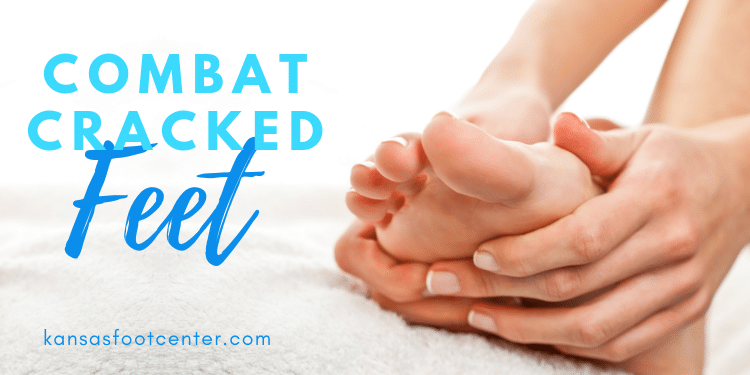Do You Get Cracked Feet in Winter? Prep Now!
A reason to be grateful we live in Kansas? We don’t get the types of winters that a Sheboygan or a Buffalo gets.
We tend to measure snowfall in inches, not feet. Temperatures tend to drop to “Oh, it’s somewhat cold.” and not “Oh, I’ve never seen that thing freeze before.”
Even so, the changing of the seasons from autumn to winter can still have effects—especially on our feet. Dryness is common, and sometimes the cold and snow do indeed become factors as well.
If you know your feet tend to suffer more during cold, dry months, there’s no better time to prep yourself than now! Having the right items on hand (well, foot) can help prevent uncomfortable situations before they begin!
So, what should you keep in mind for winter preparedness?
If Your Feet Get Dried or Cracked
A dryer atmosphere can often be felt in the feet much sooner than other parts of the body.
Why is this? The feet don’t have as many sebaceous glands as other areas, so they don’t secrete as much oils to hold moisture in. What they do have in abundance, however, is sweat glands. Moisture is lost more dramatically from the feet, and there’s not so much to stop it!
Dryness can be unsightly and annoyingly itchy in itself. When skin gets dry enough to crack, however, your feet can become painful and more prone to infection.
You’ll want to fight dryness before it has a chance to become particularly troublesome. Luckily, it’s easy to find the tools you’ll need.
- A good moisturizer and exfoliator. The best balms and lotions contain ingredients that add moisture and softness to living skin cells while getting rid of dead ones. Check the labels for ingredients such as urea, salicylic acid, alpha-hydroxy acids, and saccharide isomerate. Don’t be afraid to start using something before things get bad, and give us a call if you have any questions.
- The Right Footwear. When the weather gets colder, it helps not to expose your feet to it as often. Open-toed shoes can help you lose more moisture on colder, dryer days. Good, breathable shoes and cotton socks will protect your feet from the elements and keep them from sweating so much, too.
- Older Cotton Socks and Petroleum Jelly. Stay with us on this one. At night, before bed, apply some moisturizer/balm if you are using some, then apply petroleum jelly to your feet. This will act as a sealant, keeping the moisture in your feet overnight. The old cotton socks are just to keep the jelly from getting all over your sheets.
- Cooler Showers. The instinct might be to warm up after a chilly day out by taking as hot and steamy a shower as possible, but going too hot can actually dry your feet out faster! We’re not talking cold showers either; keep comfortable, but not overly hot.
- A Foot Soak. If you have thick heels that suffer from dryness, you might need some additional care in that area. A foot soak is a satisfying method to try. Soak your feet in lukewarm, soapy water for about 20 minutes and gently pat your feet dry with a towel before applying your balm or moisturizer. Softening the area will help the moisturizer penetrate and avoid cracks. By the way, if you want to add a little something to your foot soak for added effect, there is usually nothing wrong with doing so unless you’re going overboard. Some scented oils, some vinegar, some Epsom salts—all can be nice. Some people even swear by coconut oil after a soak, as well. Do what feels best for you; but if they cause you to have pain or a reaction, you should absolutely put a stop to using them!
- Liquid Bandage. In the case your feet do develop some cracks, a spray-on liquid bandage can provide a flexible, protective seal from exposure. Some people use super glue on their cracks, but we lean away from recommending that. It can be effective, but it can also be complicated to apply and some glues can be toxic to your skin. If you are insistent on using super glue, please let us know first to help you avoid using something that could give you a bad reaction.
Dry feet are a common problem (about 1 in 5 people will have it at some point, according to studies) but certainly not an insurmountable one.
It’s also not something that only happens during winter months for some people. If that’s you, these tips can be used all throughout the year!
However, if this advice doesn’t seem to be helping you much, or you find your feet are particularly painful or suffering from other symptoms, then it’s possible something else is causing your dry, cracked feet other than just the weather.
If this is the case, it’s time to see a professional about it. Our offices in Wichita and Newton are open at any season to help you with all your foot and ankle needs. Call us at (866) 222-5177 or fill out our online contact form to reach a member of our friendly staff.

